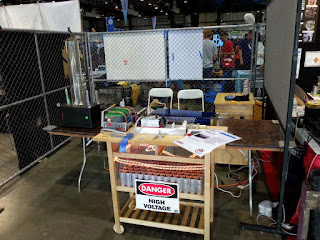2006 - I attended as a spectator, and was completely inspired. It was the best event of the year for me, and I knew I'd be coming back as an exhibitor.
2007 - I started on my Maker Faire project early in the year, and built an autonomous model helicopter that used ultrasonic beacons to locate and orient itself in space. This was long before the drone craze, and small flying devices were still pretty new. Overall, the helicopter didn't fly very well, but I still had an absolute blast. Most Makers were situated in Fiesta Hall in those early days.
2008 - I teamed up with my friend Peter, and built a set of "interactive furniture" -- furnishings that provided additional features to the owner. We had a coffee table with a rheoscopic fluid disc, a table with a refrigerator inside, a table with an espresso machine inside, a watering can that could be controlled via web interface, and speaker stands that are also aquariums.
Another friend, also named Peter, brought his electric bikes, and did a great job explaining how different hybrid drive systems worked.
2009 - I helped Peter again with his electric bikes. There was a lot interest in alternative commute vehicles. This was long before the scooter craze, etc.
2010 - I built a liquid nitrogen generator from an old cell phone RF filtering device (it used superconductors, and needed cryo to make the filters efficient). I also brought my rheoscopic coffee table again.
2011 - I built a scanning electron microscope in part because Maker Faire gave me the inspiration and venue to show it off. Youtube was also a draw, but I think without getting feedback and excitement from the crowds at earlier Faires, I may not have done it.
2012 - I brought a bunch of demos of "liquid lens technology" or electrowetting. This includes the demo of moving a stream of water with an electrically charged object. I don't know what happened to my photos. I also brought the SEM again. I was interviewed by Mark Frauenfelder this year, I think, and also gave a talk on the SEM.
2013 - Cookie perfection machine! I built a somewhat silly robot to mix ingredients to make a single cooke -- allowing ingredient proportions to be changed for each one. Again, photos seem missing.
2014 - I built a ruby laser, and did demos of blasting holes in thin steel objects.
2015 - I decided to built a true DIY project, and developed plans for folks to build their own rheoscopic disk from common parts. I wrote an article for Make Magazine describing this project.
2016 - I attended as a spectator, which is a very fun way to experience the Faire after having gone as an exhibitor for many years.
2017 - Spectator again. I'm not sure where my photos went. At some point in life, I made the effort to be more "in the moment", which meant less snapping photos, and constantly handling a cell phone.
Maker Faire has had a tremendously positive impact on my own development as a creative person, and allowed me to meet like-minded folks that I would never have been able to find otherwise. We need to make sure this positive impact is continued in other venues, or by helping Maker find a way to continue in another form. I'm very interested and willing to help.






































































